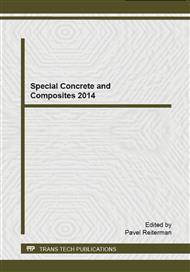p.1
p.6
p.11
p.17
p.22
p.27
p.33
p.37
Nanoparticle Injection into Concrete Using Electromigration
Abstract:
This paper aims at investigation of possibilities and effectiveness of chloride extraction from concrete and nanoparticle injection into existing reinforced concrete structures by means of electromigration technique. Concrete specimens are exposed to accelerated chloride penetration tests in order to simulate a natural chloride exposure. The developed chloride profile is removed by electroextraction by reversing the polarity in the testing chamber. In a similar manner, concrete specimens are injected with different concentrations of colloidal nanosilica particles. It was shown in the paper that chlorides can be effectively extracted from the concrete using small voltage lasting for several days. Higher concentration solutions of nanosilica can also be effectively transported into concrete via the electric field. Once injected nanosilica can act as microstructure densifier and further reduce chloride penetration as demonstrated by decreased diffusivity of the treated concrete.
Info:
Periodical:
Pages:
6-10
Citation:
Online since:
October 2014
Authors:
Keywords:
Price:
Сopyright:
© 2014 Trans Tech Publications Ltd. All Rights Reserved
Share:
Citation:


